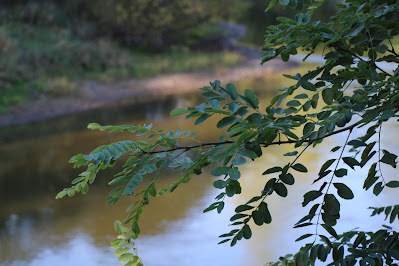This morning, I’m greeted by sunny skies, chilly temperatures and a gusty west breeze as I begin my hike in the 17-acre, Mill Pond Natural Area, one of the newest preserves owned by the Chippewa Watershed Conservancy. After pausing to watch the Chippewa River flow east toward the rising sun, I make my way along the shore where I spot Raccoon tracks in the mud and dozens of tiny Whirligigs darting over the water surface. Up ahead, I notice a Mallard drake swimming upstream and a 1-inch, male Autumn Meadow Hawk dragonfly basking on a large flat rock. Turning away from the water into the floodplain, I spot several patches of dried stalks of the notorious Garlic Mustard plant that had previously foliated and flowered (stock photo). This species has become one of Michigan’s most invasive weeds, rapidly dominating the forest floor while destroying woodland habitat for many plants and animals. One mother plant can produce thousands of seeds that may remain viable for up to 10 years and while growing, its lateral roots are spreading rapidly, producing chemicals in the soil that repel native plants. Nearby, I come upon some fresh edible and favorable fungi called, Chicken-of-the-woods. Next, I pause to observe a never-before-seen shrub called, Black Jetbead with its fruit clusters. Rarely seen in Michigan, this plant is known to invade forested areas, creating a thick shrub layer which can displace native shrubs and shade out understory species. The berries are highly toxic to humans and can be fatal if eaten. Symptoms, include difficulty breathing, weakness, excitement, pupil dilation, abdominal pains, vomiting, spasms, convulsions, coma and respiratory failure. Hiking over the dry, crunchy leaf litter, I look up to see a Catalpa tree with its large leaves and foot-long seed pods. These trees are the sole source of food for catalpa worms—caterpillars that feed on the foliage (stock photo). These 2-3 -inch long worms are valued as fish bait whereas some fishermen plant the trees solely for this purpose. Eventually the caterpillar turns into a Catalpa Sphinx moth (stock photo). Nearing the car, I look up to observe the leaves of a never-before-seen tree, called a Chestnut Oak. Rarely seen this far north, this species of oak gets its name from Chestnut-like leaf structure. A closer observation reveals the presence of a round Bullet Gall on one of the leaves. This growth occurs after a tiny female wasp deposits an egg on the leaf. Subsequently, the spherical gall grows around the developing larva (stock photo).
Coo of a dove
Or propeller above
Buzz of the bees
Or blower of leaves
Babbling streams
Or siren that screams
Killdeer afar
Or muffler-less car
Sandhill cranes
Or low-flying planes
Hammering nails
Or tranquil trails
D. DeGraaf

No comments:
Post a Comment